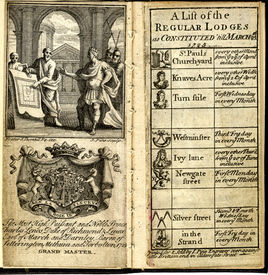
HISTORY OF FREEMASONRY
Various theories speculate on the beginnings of Freemasonry, with hypotheses ranging from ancient builders to medieval stonemasons.
Theory 1
According to one theory, the operative stonemasons responsible for constructing grand cathedrals and castles convened in lodges where they discussed trade matters. Their initiation ceremonies were uncomplicated, and in the absence of official certifications, dues cards, or trade union memberships, they adopted confidential signs and terms to affirm their masonry skills when relocating to new sites. During the 1600s, these operative lodges began to admit non-operative individuals, referred to as "gentlemen masons." Over time, these non-operatives assumed leadership roles in the lodges, transforming them from operative to "free and accepted" or "speculative" lodges.

Theory 2
The alternate theory suggests that in the late 1500s and early 1600s, a group emerged with a profound interest in promoting religious and political tolerance during a period marked by widespread intolerance, where differing beliefs in religion and politics often led to violent civil conflicts. Their aim in founding Freemasonry was to cultivate better individuals and contribute to the creation of a more harmonious world. Given the prevailing teaching methods of the time, which relied on allegory and symbolism, they centered their system around the allegorical concept of construction.
The primary source of their allegorical inspiration was the Bible, a universally recognized text, even among those who couldn't read. The Bible's most detailed account of construction was King Solomon's Temple, which served as the cornerstone of their ritual. They drew upon the organizational structure of the old trade guilds, incorporating roles like Master, Wardens, Treasurer, and Secretary. Additionally, they found a wealth of symbolism in the tools of operative masons to convey the moral teachings of Freemasonry effectively.
The earliest documented instance of an English speculative mason can be traced back to 1646 when Elias Ashmore underwent initiation in a Lodge in Washington. It's important to note that others in attendance and listed may have been initiated even earlier.
On June 24, 1717, which coincided with St. John's Day, four longstanding London Lodges convened at the Goose and Gridiron Tavern located in St. Paul’s Churchyard. During this gathering, they formally declared themselves as a Grand Lodge and chose Anthony Sayer as their first Grand Master. This historic event marked the establishment of the world's very first Grand Lodge, known as the Premier Grand Lodge, a pioneering institution and the precursor to the formation of the United Grand Lodge of England.
Subsequently, Ireland established its Grand Lodge in 1725, and Scotland followed suit in 1736. Virtually all recognized Grand Lodges globally can trace their origins back to one or more of the Grand Lodges in the British Isles.










